They were the first: Laumann and Borchard's pistols
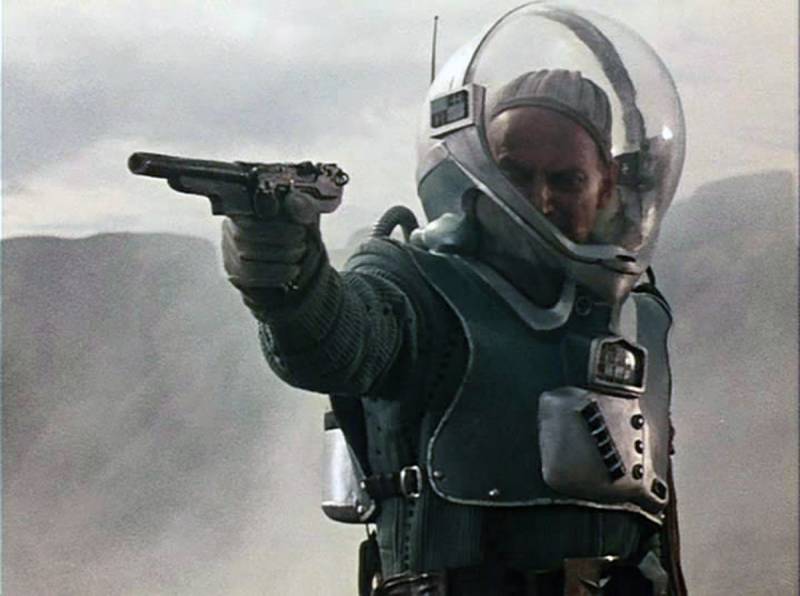
When in 1961 the science fiction film Planet of Storms by director Pavel Klushantsev was released on the screens of the USSR, I noticed an unusual pistol in the hands of the American astronaut Allan Kern. I thought it was some kind of unusual "fantastic pistol" especially for Venus. And only today I learned that he was shooting from Borchard's pistol, model 1893 - K-93!
Genesis 25:25
History firearms weapons. And it so happened that the machine gun of Hiram Maxim, which he created in 1884, significantly spurred the work of designers in this area around the world. Including those who worked on pistols, trying to make them multi-shot and rapid-fire.
One of these weapons designers was the Austrian Josef Laumann, who lived in the town of Ottakring, which after 1892 became a suburb of Vienna. Already in 1889, he designed his first five-shot pistol with an original manual control and a five-round magazine, a patent for which he received in 1890. The pistol had a cylindrical breech and a capacity for a cartridge clip, located "in Mauser" style. The shutter was controlled by a lever with a slot in the rear, which included the trigger. You feed it forward - the shutter moves back. You pull back - the bolt goes forward, while a cartridge from the magazine enters the barrel, the bolt locks the barrel, followed by pressing the trigger and shooting!
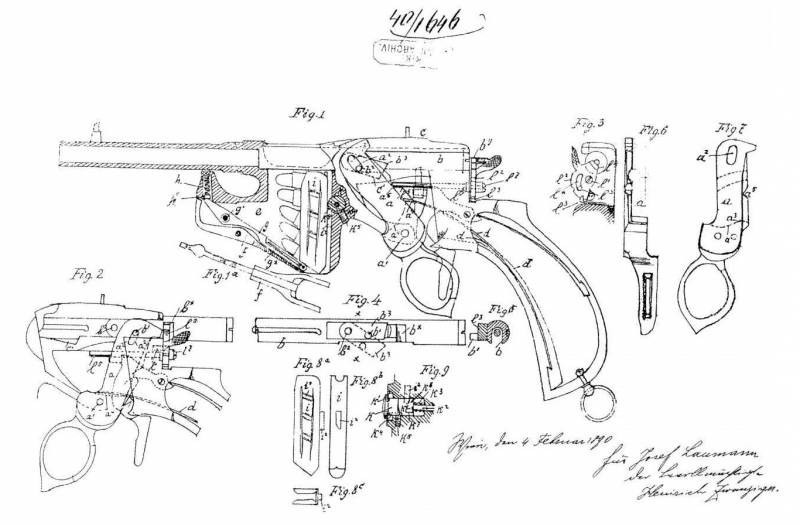
Diagram of the very first Laumann pistol, model 1891. The shutter, as you can see, was locked behind the fuse, which swung open when pressed down
The designer tried to refine this basic model. He created several pistols with a bolt controlled by a lever, for which he again received several patents.
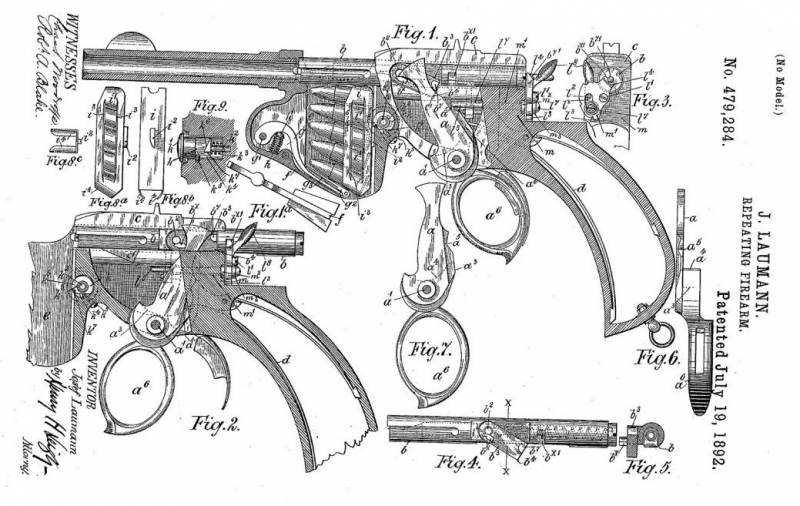
Diagram of a Laumann pistol model 1891 under a patent of 1892[/ Center]
And it was then that the thought occurred to him that all this same bolt in his pistol can be made to be done by the force of recoil! He quickly remade it and already on June 9, 1891, applied for an Austrian patent for the first self-loading pistol in history. True, he received it only on November 25, which gives reason to some historians to consider the first pistol of Salvator Dormus, since his patent was issued on July 11, 1891. In design, it resembled his first pistol with a cocking lever, but was completely self-loading. Apparently, due to haste, he did not come up with anything better than how to use the front part of the trigger guard, which, as before, should have been taken forward. It was necessary to introduce an uncoupler into the design, which put the trigger in a position that did not interfere with the movement of the shutter. Whether at least one pistol of this design was made is unknown.
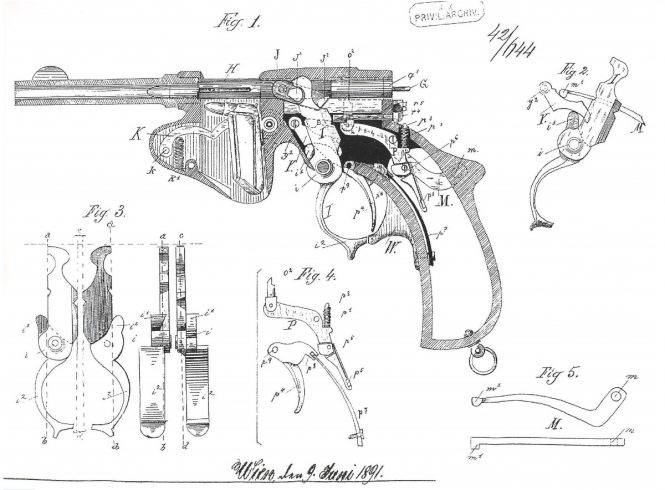
Diagram of the M1891 pistol with a shutter control by the front of the trigger guard
It is clear that this design was not very convenient from the point of view of its use. Therefore, Laumann altered this pistol already in 1892. Now the bolt was cocked by a massive lever located on the receiver to the right in front of the trigger. Also not the best option, but ... he did just that! Interestingly, in the Laumann self-loading pistol, a semi-free breech was used, the opening of which was carried out with deceleration due to high friction in the lever system. That is, it was ... a friction breech that allowed to reduce the weight of the breech and the power of the return spring. Moreover, everything was calculated so that when the shutter was manually cocked, there was no friction or braking. It only occurred when fired! An original solution, to be sure. Several dozen such pistols were made. The total length of the pistol was 228 mm, the barrel was 142 mm long, and the weight was impressive - 1109 g. But there were clearly few cartridges in the store - only five 7,8-mm caliber Laumann's own design. These pistols were handed over to the Austrian military for testing, but they, having tested them, rejected this model in 1896.
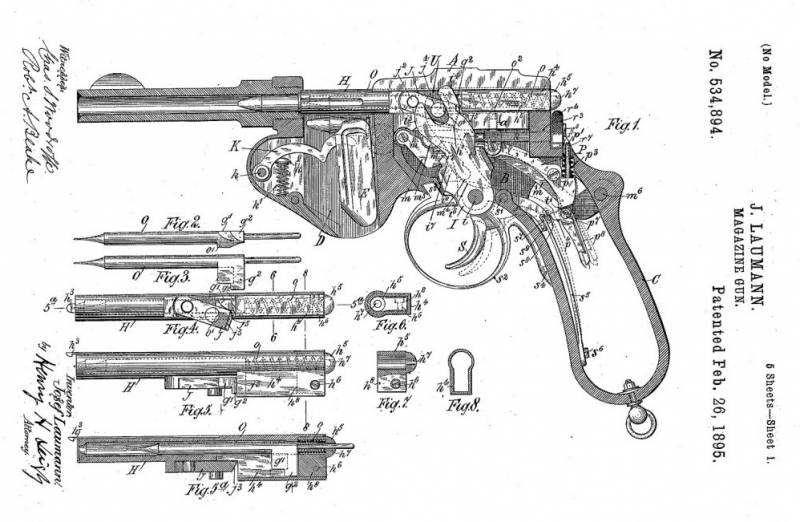
Diagram of the Laumann pistol device and its bolt according to American patent No. 534894 dated February 26, 1895
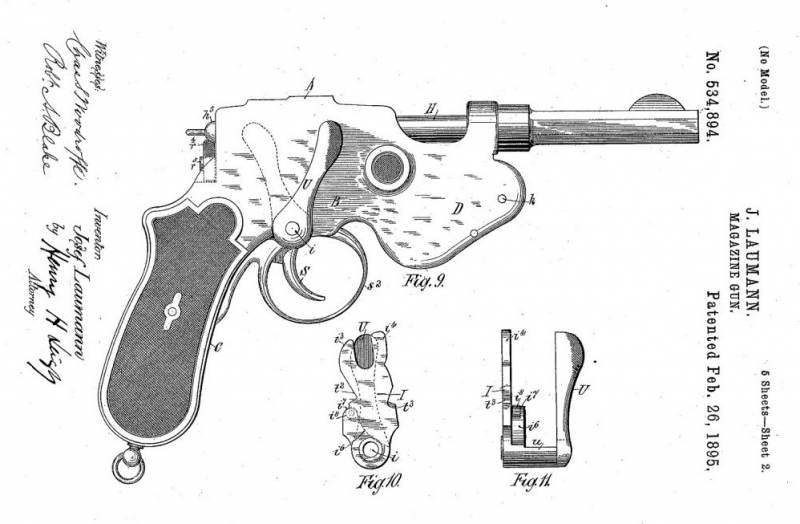
This is the cocking lever on the right. Laumann pistol scheme according to the American patent of 1895. Round button with grooves - clip holder in the store
It is interesting that in a number of sources this and other Laumann pistols have a double name: Schönberger-Laumann. Which, by the way, is not surprising, since it is known that since 1890 Laumann received financial assistance from the Schönberger brothers, and then they also acquired his patents. There is evidence that one of the brothers was the manager of the Austrian arms factory "Österreichische Waffenfabriks-Gesellschaft" in Steyr, so this is not surprising. There is also the Schoenberger-Laumann M1894 pistol, which used 8mm cartridges, known as the Schoenberger 8mm.
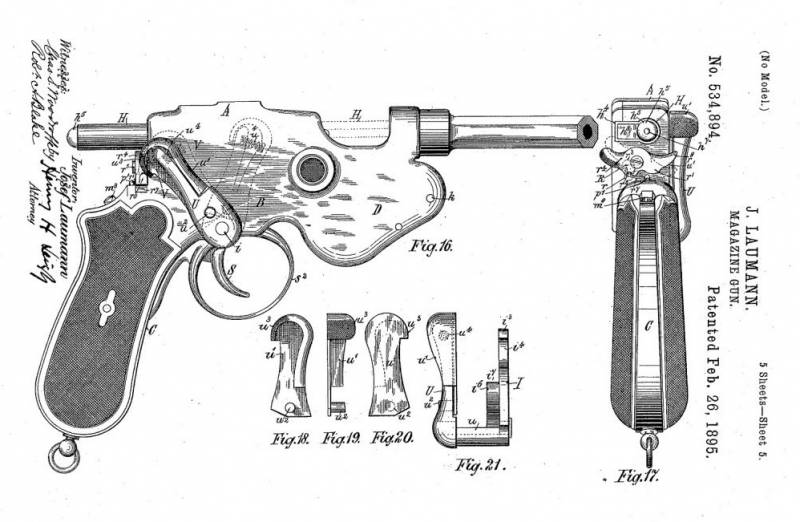
Diagram of the Laumann pistol device according to US patent No. 534894 dated February 26, 1895. The fuse device is clearly visible. Detail P1 - indicator of the cocked striker
Another important detail appeared on the Schoenberger-Laumann pistol of the 1894 model: the rod in the rear side of the bolt in front of the safety catch. If he protruded above the frame, this meant that the drummer was put on a combat platoon. The total length of the pistol was 321 mm, barrel length 145,7 mm, weight 1256 g. There were two models of this pistol of the same weight, but differing in size. Both pistols had a batch loading, which is very typical for weapons produced in Austria-Hungary. In the stores of both pistols, a pack of five 8mm Schönberger rounds was placed.
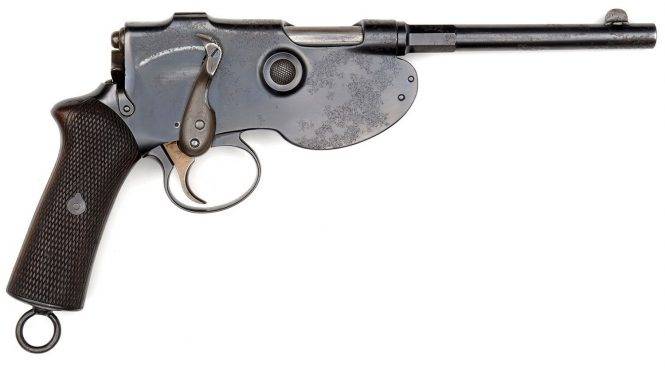
Laumann pistol M1892, right side view
By the way, it was the batch loading that became one of the reasons why this pistol did not become widespread. In addition to the complexity of the mechanism and high requirements for the quality of manufacturing, loading a pistol with a pack turned out to be very inconvenient, and its capacity is small. If the creators of the pistol had put on it, say, the same six- or ten-round removable magazine, then ... it could well be that this particular pistol would have occupied the niche of the Mauser K96 pistol. That is, the failure of the pistol befell primarily due to a certain traditionality of its ammunition supply system!
It was not at all the same with Hugo Borchardt's K93 pistol - in fact, the world's first truly successful model of self-loading weapon chambered for a pistol cartridge. It was created by Hugo Borchardt - at that time he was the chief engineer of the arms company "Ludwig Loewe and Co", which in 1896 became part of DWM (Deutsche Waffen und Munitionsfabrikenruen), a large enterprise for the production of various types of weapons, as well as ammunition, which shortly before this (in 1889) was founded in Karlsruhe, Baden-Württemberg. Well, after 1896, Berlin became the headquarters of DWM.
Borchardt took up his pistol at the very beginning of the 90s, and already at the beginning of 1893 the first sample of his pistol was ready. That is, he worked quite a bit behind Joseph Laumann with his M1892 pistol.His design was patented first in England, then in Germany, France, Italy and the USA, and even here in Russia, where he received a privilege for a period of 10 years ... In this document, his weapon was named like this: “Recoil pistol».
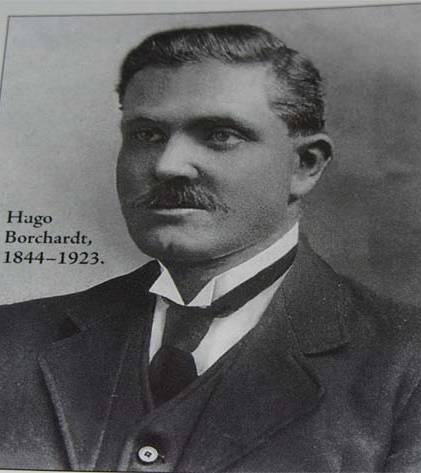
Hugo Borchardt in his youth. It is interesting that he began his career as a gunsmith ... in the USA, where he worked for Winchester and even developed several revolvers of his own design, preserved in the museum of this company. The weapon was quite modern, but since the Winchester company just at that time agreed with the Colt company on the division of spheres of influence, they did not release it. And then he returned to Europe and started working in Germany, the benefit of experience he did not take
This is not surprising, because the idea of a weapon that could shoot itself and, moreover, many, many times, was literally in the air in those years. But its implementation in practice was held back by ... black powder cartridges. Even a novice shooter, having a "cowboy" Winchester with Henry's bracket, could easily fire 30 shots in one minute, and after some training, all 60. But the target from him would be hidden by a cloud of thick smoke, unless he had to shoot in a strong wind ... Well, self-loading weapons would require even more ammunition, and besides, there would be even more smoke from it, not to mention the fact that the products of its combustion would greatly pollute the automation of such weapons. But as soon as there were cartridges equipped with smokeless powder, the situation began to change almost immediately. And the wars themselves gradually became completely different ...
It was for these very new conditions and cartridges with smokeless powder, which he himself invented, Hugo Borchard and designed his pistol.

Borchard's pistol, 1894, from the Glenbow Museum in Calgary, Alberta, Canada
At that time, crank-crank mechanisms were in great fashion, the same locomotives were in front of everyone's eyes, so he did not come up with anything new, but simply took and attached to the long pistol barrel a crank-crank mechanism controlling the shutter, with an uncoupler and sear, however, the magazine with a spring-loaded feeder was made removable, placing it in the handle of the simplest outlines. He also came up with the idea of installing a removable stock on his pistol, half consisting of his own holster, with which he turned into a pistol-carbine.
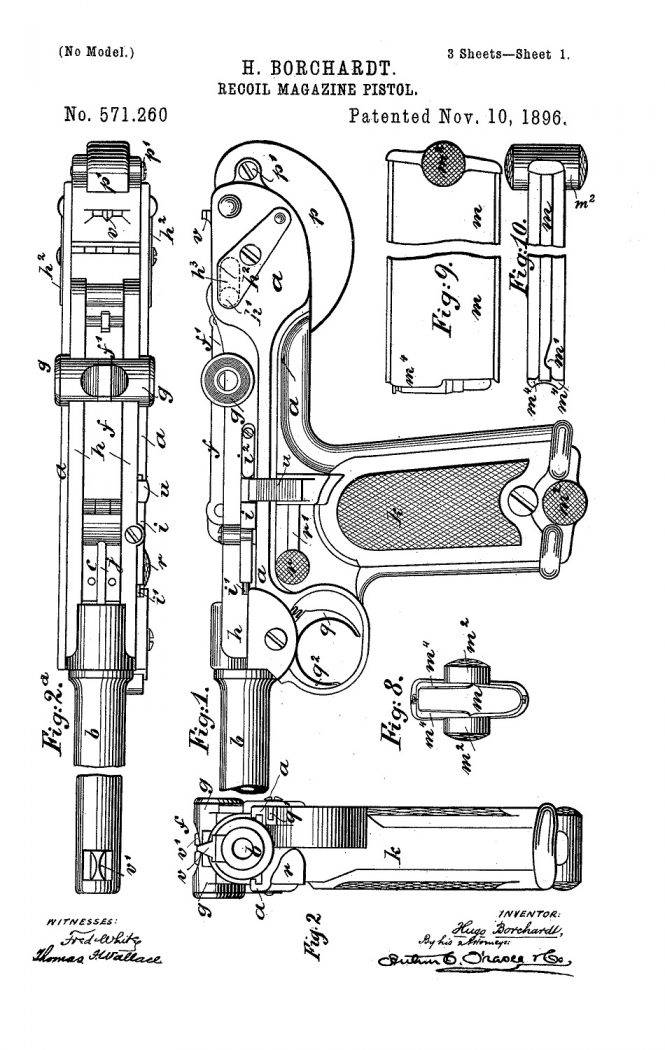
Diagram of Hugo Borchardt's pistol device from patent No. 75837
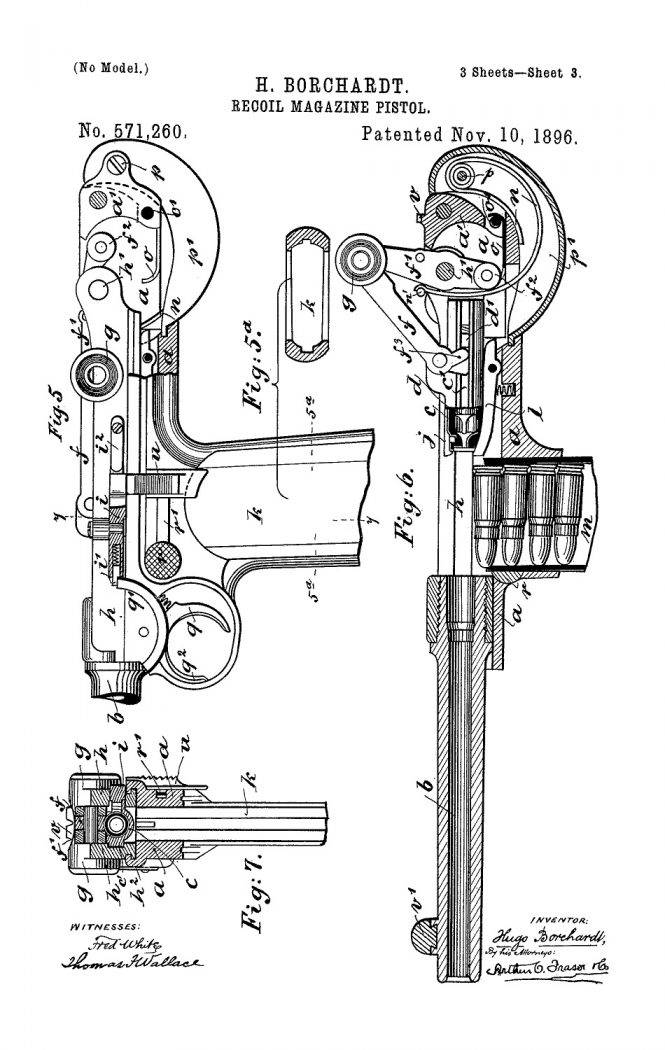
The work of the mechanism of Borchard's pistol. Diagram from patent No. 75837
Due to the fact that the entire mechanical part of the pistol - the butt plate of its frame and the casing covering the return spring - turned out to be shifted quite far back, the pistol acquired a somewhat unusual appearance, but it was quite convenient to use it. So, the cocking handle, and the safety catch, and the store button were on the left of the pistol and were easily controlled with the left hand.
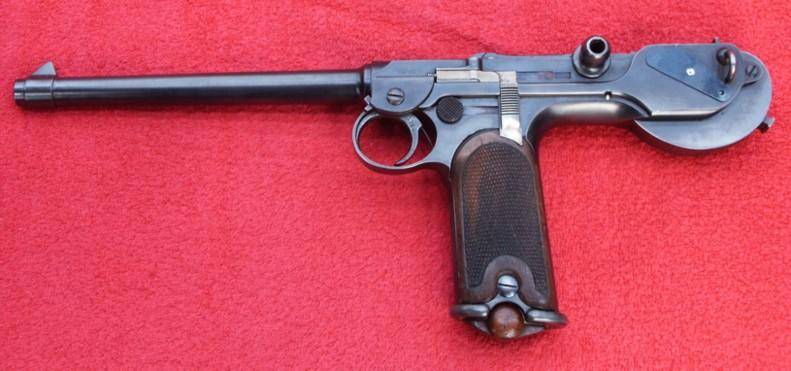
Borchard's pistol K93, left side. The fuse is clearly visible: a vertical plate with a transverse notch, as well as a large grooved magazine release button, which is spring-loaded by the same leaf spring as the fuse plate. (Photo by Alain Daubresse website www.littlegun.be)
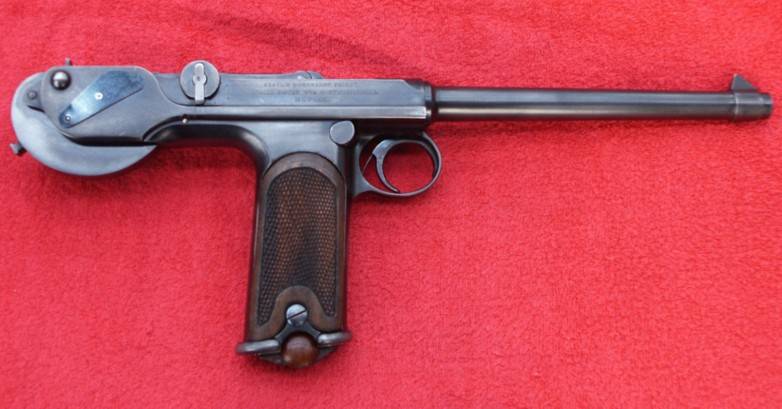
On the right side of the pistol, there are no parts that control it. (Photo by Alain Daubresse website www.littlegun.be)
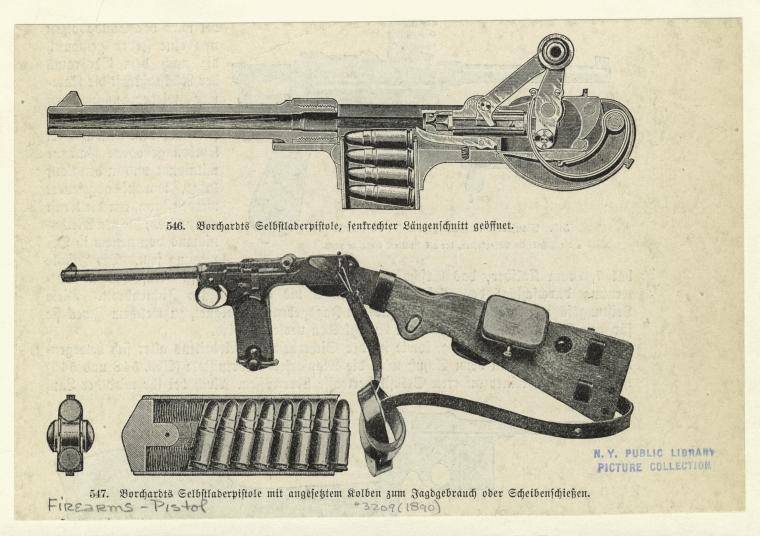
Borchard's pistol automatics worked due to the short stroke of the barrel back when fired, that is, it used the recoil force. The shutter was locked by the levers of the crank mechanism
When fired, the barrel, as well as the bolt box and the bolt itself retreated back along the guides on the pistol frame. At the same time, having passed a short distance, the rollers of the rear of one of the shutter levers rested against the rear of the frame, which had the shape of a slide. The rollers moved up this hill, and the bolt levers folded, coming out of the dead center - that is, the position at which the barrel was locked by the bolt. The bolt itself continued to move and retreated even further back, while removing the sleeve from the chamber. At the same time, a special protrusion of the lever cocks the drummer and compresses the mainspring. A recoil spring in the form of two metal strips, located in a special casing in the rear of the pistol, presses on the bolt, and now it goes forward, grabs another cartridge from the store and sends it into the barrel, while the drummer is fixed with a sear and becomes combat platoon. The bolt comes to its extreme forward position, the barrel is locked, and the pistol is ready for the next shot.
The pistol's sights are the simplest: a triangular front sight on the barrel and a rear sight located on the pistol frame at the rear.
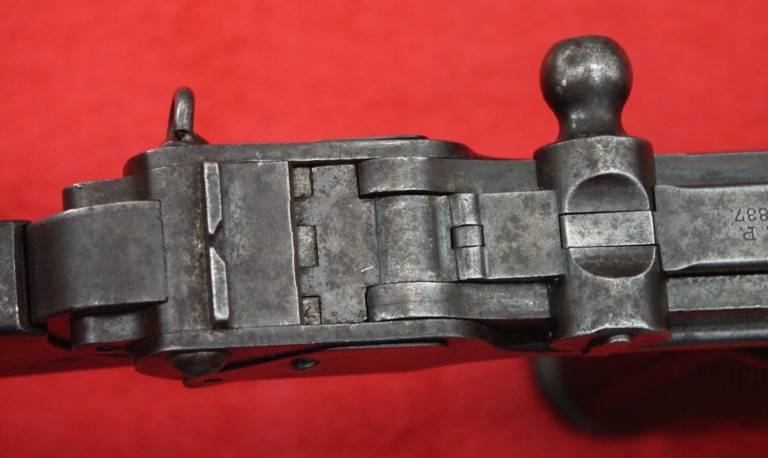
Rear sight and bolt cocking handle. (Photo by Alain Daubresse website www.littlegun.be)
A removable wooden buttstock is attached to the weapon using a T-shaped protrusion located on the recoil spring casing. The pistol weighed about the same as Laumann's pistol: with an unloaded magazine and without a butt - 1270 g, the length without a butt was 352 mm, and with a butt - 680 mm, the barrel had a length of 190 mm (or 154 mm), the magazine capacity was eight cartridges 7,65 × 25 mm Borchardt.
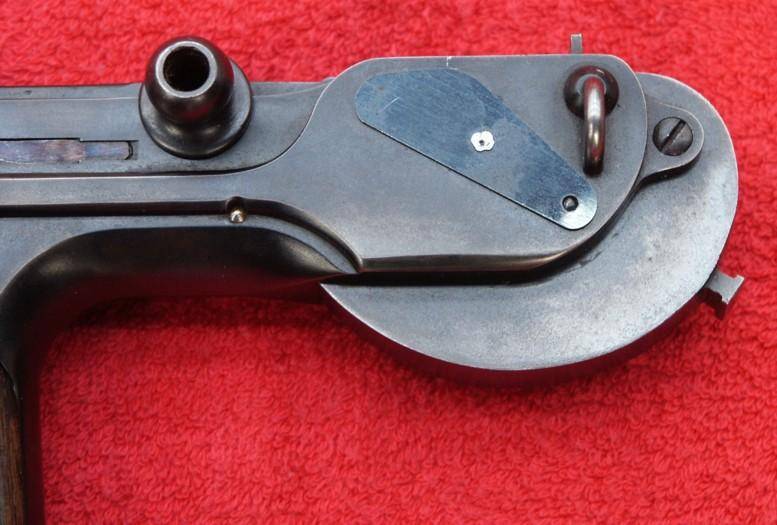
T-shaped protrusion for attaching a removable stock. (Photo by Alain Daubresse website www.littlegun.be)
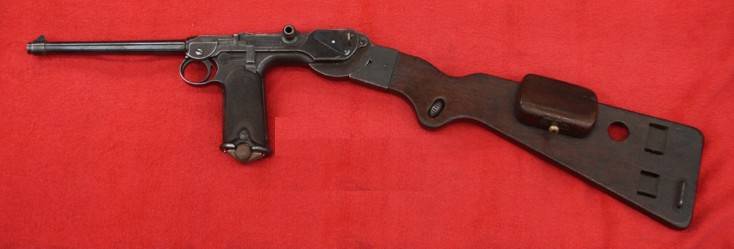
K93 pistol with an attached butt holster. (Photo by Alain Daubresse website www.littlegun.be)
Like many other gunsmiths of that time, Borchardt also created the original 7,65 mm caliber cartridge for his pistol, which received his name. With this cartridge, his pistol had a rate of fire of 72 rds / min, while the cartridge made it possible to give a 5,5-gram bullet an initial speed of 385 m / s. And since the barrel of the pistol was quite long, at this speed of the bullet, the accuracy was very good. And everyone liked this cartridge so much that it served as a prototype for cartridges for pistols of Bergman, Mannlicher, Mauser, Tokarev and for the Japanese pistol Nambu.
Hugo Borchard, in every sense, went further than Laumann and on his pistol used a number of completely new and previously unheard of technical solutions, but later applied on almost all subsequent models of pistols. Among them:
Detachable magazine with placement in the handle.
Push-button magazine latch, on the left side of the pistol frame.
Rantless chuck with bottle-shaped sleeve with annular groove for extractor tooth.
Lead bullet in a metal sheath.
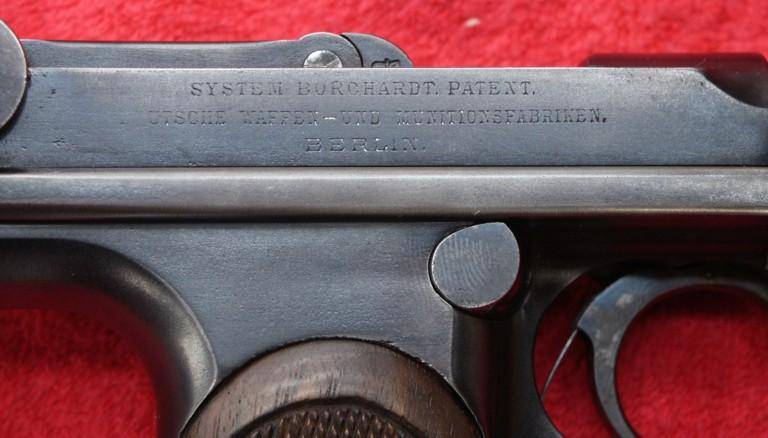
Borchard's pistol marking. (Photo by Alain Daubresse website www.littlegun.be)
By the way, Berhard's cartridge turned out to be so good that Joseph Federle and his two brothers, who developed their K96 pistol at Paul Mauser's factories, immediately used it on it. True, the charge of the cartridge was strengthened by them due to the use of better quality gunpowder, and its very weight in the cartridge was increased. Accordingly, the bullet speed increased to 420 m / s. Well, later the same cartridge was used for pistols and submachine guns created by Soviet designers - the TT pistol and PPD and PPSh submachine guns. The same cartridge, but in a shortened version (from 35 mm to 30 mm), was used in the pistol of the German designer Georg Luger and in the Nambu pistol of the Japanese general Kiyiro Nambu.
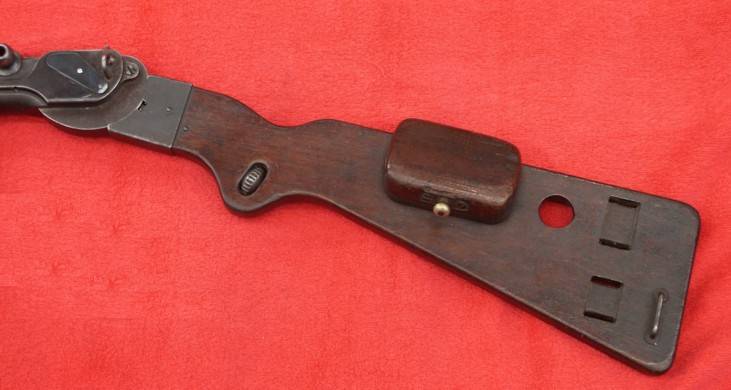
Close-up of the butt. Left view. (Photo by Alain Daubresse website www.littlegun.be)
It was also very important that Borchard created a perfectly working shop for his pistol. I even thought of such a trifle as holes on its planes to control the number of cartridges. In early stores, the feed spring was flat, riveted from 12 steel plates. But in 1895, it was replaced with two twisted ones, and ribs were made on the store's body. The shop floor was different from modern designs and was made of ... walnut. The cheeks of the pistol grip were also made of walnut and were attached to the frame with screws - each with its own. The wooden butt on one side was connected to a leather holster, or rather - it was a leather pistol holster that was attached to a wooden butt!
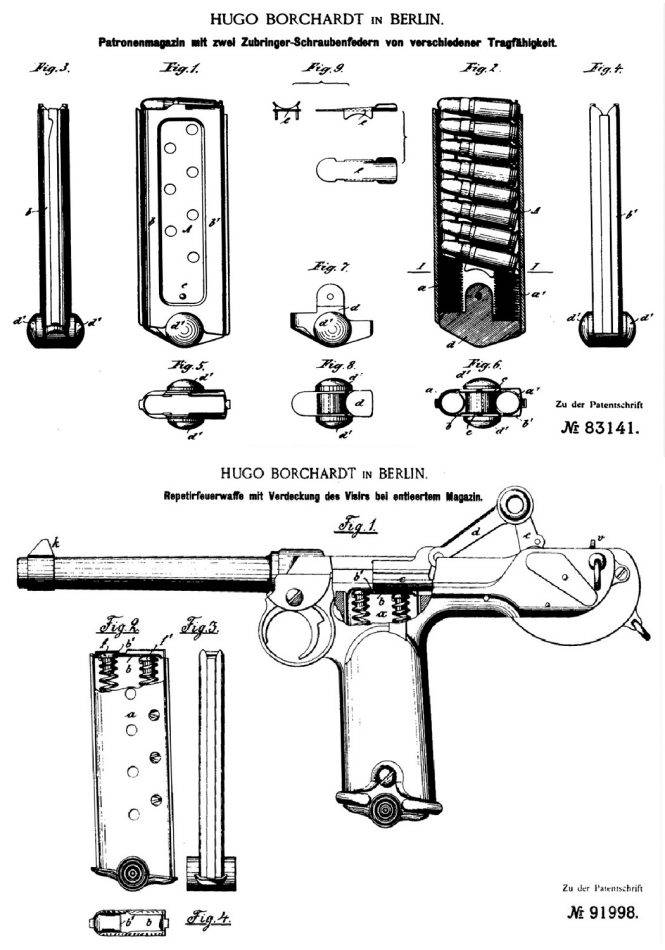
The device of the store from the German patent Borchard No. 91998
The appearance of the K93 pistol at once crossed out all previous pistol designs and caused a whole storm of responses in the press, and all the responses were mostly enthusiastic. The opinion of the military, however, especially the Russians, was more restrained. So, after testing a pistol in Russia in 1898, it was noted that it is more convenient to load and unload it than the "Mauser" with its round-robin loading; that it is safer than the Mauser, since when the magazine is inserted it is still not charged, and its drummer is not cocked; But the bad thing is that the pistol does not have a slide stop and an indicator of the presence of a cartridge in the chamber. Although the pistol was disassembled into only 10 parts during incomplete disassembly, the Russian military considered that this was too much for the lower ranks, and that they would lose locking screws and pins. In addition, the pistol worked flawlessly only when well lubricated and was very sensitive to contamination.
Advertising of Borchard's pistol in Russia. 60 royal rubles for a pistol is a lot of money. At the beginning of the XNUMXth century, one ruble could buy a load of firewood, not very large, but a load of two cubic meters, no less!
Borchard received a German patent for this pistol, number 75837, on September 9, 1893, and soon the plant of Ludwig Leve began its production. In total, about 3000 of these pistols were fired. Interestingly, its creator himself soon lost interest in weapons and did not even try to improve his design based on the comments made to him by the military. Another person already had a chance to do this ...
To be continued ...
Information